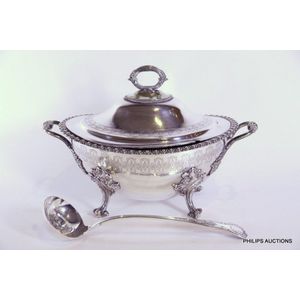Victorian Silver-Plated Tureen and Ladle
You must be a subscriber, and be logged in to view price and dealer details.
Subscribe Now to view actual auction price for this item
When you subscribe, you have the option of setting the currency in which to display prices to $Au, $US, $NZ or Stg.
- Victorian Period - The Victorian period of furniture and decorative arts design covers the reign of Queen Victoria from 1837 to 1901. There was not one dominant style of furniture in the Victorian period. Designers used and modified many historical styles such as Gothic, Tudor, Elizabethan, English Rococo, Neoclassical and others, although use of some styles, such as English Rococo and Gothic tended to dominate the furniture manufacture of the period.
The Victorian period was preceded by the Regency and William IV periods, and followed by the Edwardian period, named for Edward VII (1841 ? 1910) who was King of the United Kingdom and the British Dominions and Emperor of India for the brief period from 1901 until his death in 1910. - Finial - An architectural decoration, found on the upper parts of of an object. On furniture they are usually found on pediments, canopies and shelf supports. On smaller ceramic or silver items, such as spoons, they may decorate the top of the item itself, or the lid or cover where they provide a useful handle for removal.
Finials have a variety of shapes and forms. They may be urn-shaped, baluster shaped round or spiral, but usually taper into an upper point. Many real life shapes may also be used as finials, such as pineapples, berries, pinecones, buds, lotus and acorns. Sometimes animals such as a lion are depicted, or fish and dolphins. - Frieze - An architectural term denoting the flat, shaped or convex horizontal surface of furniture, between the architrave and the cornice, usually found on a cabinet or bookcase, or on desks and tables where it may include drawers, the area between the top and the legs. In ceramics, the term refers to the banding, of usually a repeating pattern, on the rims of plates and vases.
This item has been included into following indexes:
Visually similar items

Victorian sterling silver sauce tureen, mark of Robert Hennell II, London, 1841, of oblong shape, with twin handles, crested, raised on four scroll and shell feet, the lid surmounted by a fruit finial, hallmarked, weight 493 grams height 12.5 cm. Provenanc

A George II silver two-handled cup and cover, Peter Archambo, London 1731, of inverted bell shape, on spreading circular foot and with moulded ribbed mid-band, leaf-capped double scroll handles, one side engraved with a Coat of Arms, the domed cover with b

A George III Scottish sterling silver hot water jug by Robert Gray & Son, Edinburgh 1807 with half fluted body below band of engraved decoration and cone finial, 26 cm high, 1,025 grams

An Edwardian silver mustard pot, quatrefoil form, on shell-capped stylized paw feet, blue glass liner, Birmingham 1906
